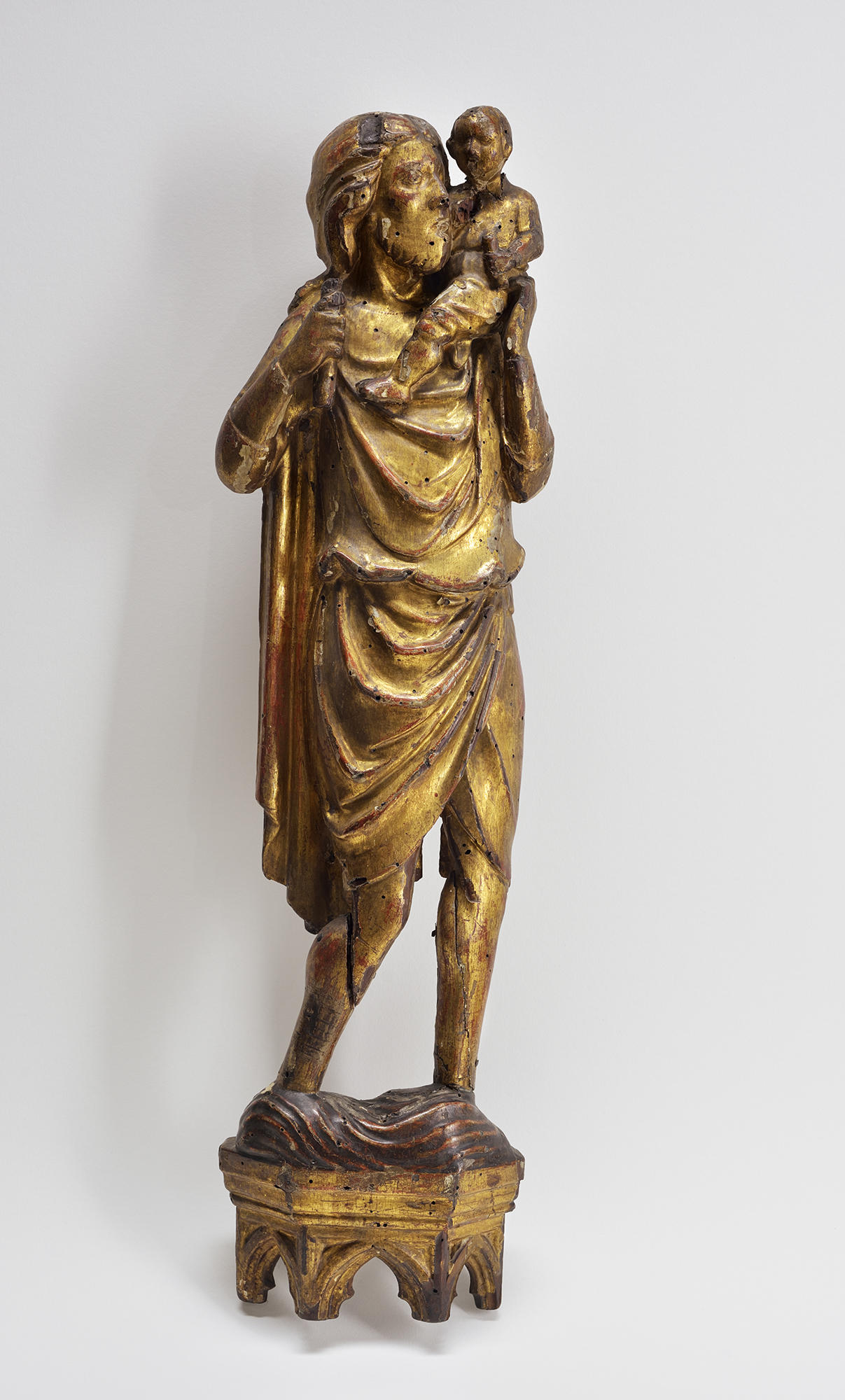Isabella Stewart Gardner and her husband Jack loved to travel. Much of the Gardner Museum's collection is a compilation of objects and artworks either acquired by Isabella or Jack during their world travels or at least inspired by them. But in a few galleries, Isabella displayed examples of a curious figure who perhaps played a more spiritual role in their journeys: Saint Christopher.

Isabella Stewart Gardner Museum, Boston (v.1.a.4.3, page 1)
Isabella Stewart Gardner (American, 1840–1924), Travel Album: England, Volume I, 1879. Bound album: photographs, ink, paper, 32 x 20 x 4.5 cm (12 ⅝ x 7 ⅞ x 1 ¾ in.)
The Legend of Saint Christopher
Saint Christopher is revered as the patron saint of travelers, protecting them from bad weather, accidents, sudden death, and any other malady that might befall them on their journey. The legends of this character vary widely, but a version of the story emerged in the 13th century, which became highly influential on medieval and Renaissance art, and modern Catholic beliefs. Initially named Reprobus, meaning "the reject," the character of Saint Christopher is documented as being a giant. He was in service to the king of Canaan but sought to serve an even greater king. Guided through teachings of the Christian faith by a mysterious hermit, Reprobus determined that Christ was the ultimate leader he should serve. He was then baptized and given the name Christophoros, meaning "Christ bearer."
The hermit suggested that Christophoros could serve Christ by helping people across a dangerous river where many were dying in their attempts. One day, a small child asked him to carry him across; as they crossed, Christophoros felt the child getting heavier. Once safely across, he scolded the child for putting him in danger, comparing the heaviness he felt to the weight of the world. The child revealed himself to be Christ and told Christophoros that he indeed was carrying the weight of the world on his shoulders, as well as the eternal source from which it came. The child instructed him to plant his staff in the ground, and just then, it turned into a tree bearing fruit to reward him for his efforts. Then the child vanished. Based on this legend, depictions of Saint Christopher often show a small child on his shoulder and a staff in one hand.

Wellcome Library no. 4646i, CC BY 4.0 <https://creativecommons.org/licenses/by/4.0>, via Wikimedia Commons
Italian, Saint Christopher Prayer Card. Color lithograph
Isabella's Saint Christophers
There are three depictions of Saint Christopher in the Gardner Museum's collection. Interestingly, Isabella placed one on each floor, perhaps she wanted to ensure that visitors were securely guided on their journey through the Museum.
Visitors may first encounter Saint Christopher in the North Cloister on the first floor. A sculpture made of Istrian stone, this Saint Christopher is perched on top of a column watching over passersby. A child is set on his shoulder and is holding a small sphere, meant to represent the world. A staff is missing from his grip, but perhaps Isabella was being playful with his display next to the Courtyard: is the Courtyard meant to be the lush product of his staff being planted?

Isabella Stewart Gardner Museum, Boston (S10s1). Photo: Julia Featheringill
Italian, Northern Italy, Saint Christopher, early 16th century. Istrian stone, 109.22 cm (43 in.) high
Traveling up to the second floor, another Saint Christopher is found in the Short Gallery. Within one of the cabinets is an ink drawing showing more detail of the legendary story. In this drawing, the viewer can see not only Saint Christopher with the Christ child on his shoulder, but also his staff already growing and appearing as a tree branch, as well as a small hooded figure meant to be the hermit. Isabella purchased this drawing at auction in 1902, although her motive for this purchase is unclear: at the time, the drawing was attributed to Leonardo da Vinci, which may have enticed her more than the subject matter. This attribution was later disproven and the actual artist is currently unidentified.

Isabella Stewart Gardner Museum, Boston (1.2.o.18)
Flemish, Flanders (?), Saint Christopher Carrying the Christ Child, 16th century. Brown ink and wash on paper, 14.6 x 20.3 cm (5 ¾ x 8 in.)
The last depiction of the saint is on the third floor in the Chapel. Here, Isabella displayed the oldest depiction of Saint Christopher in the collection: a 14th-15th century gilded sculpture carved from linden wood. It is barely visible, tucked away in one of the choir stalls next to the Soisson Cathedral stained glass window.

Isabella Stewart Gardner Museum, Boston (S28w2)
Italian, Venice, Saint Christopher, about 1400. Gilded lindenwood, 58.5 cm (23 1/16 in.) high
Saint Christopher Today
Imagery showing Saint Christopher is pervasive to this day. Pendants, medallions, statues, candles, jewelry, even car air fresheners can be found displaying an image of him. The belief is that looking upon an image of him will protect the faithful during their travels.
In 1969–1970, Christopher was one of 93 saints stripped of their sainthood by the Roman Catholic church, particularly due to rising doubts that he ever existed. Despite this, Saint Christopher remains very popular. People from all religious backgrounds can be found celebrating his feast day on July 25th, and adorning themselves with keepsakes of his image. If you plan on traveling, he clearly makes a great travel companion.
You May Also Like:

Explore the Exhibition
Fellow Wanderer: Isabella's Travel Albums

Explore the Exhibition
Betye Saar: Heart of a Wanderer

Gift at the Gardner
The Little Book of Saints